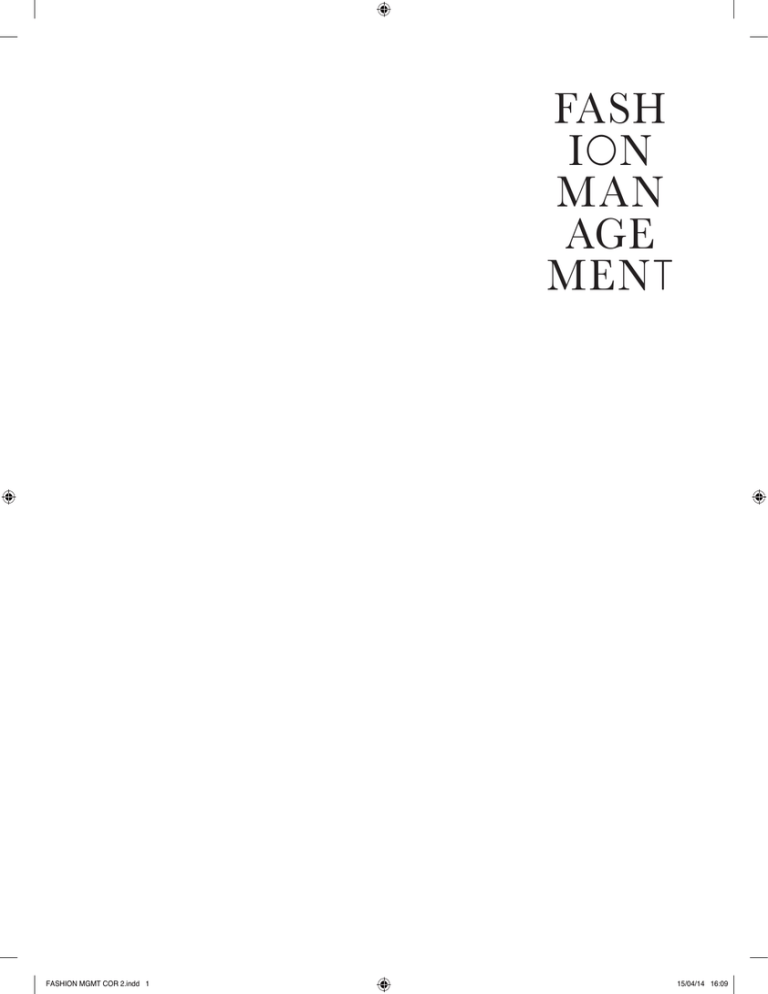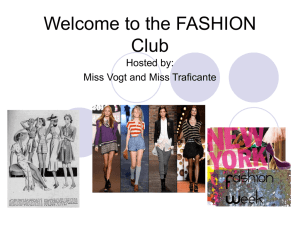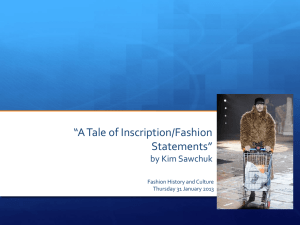FASHION MGMT COR 2.indd
advertisement

Fash io n man age men t FASHION MGMT COR 2.indd 1 15/04/14 16:09 FASHION MGMT COR 2.indd 2 15/04/14 16:09 Annick Schramme Trui Moerkerke Karinna Nobbs FASHION MGMT COR 2.indd 3 15/04/14 16:09 FASHION MGMT COR 2.indd 4 15/04/14 16:09 6 PREFACE | Fashion management in the age of globalization Jennifer Craik 13INTRODUCTION Annick Schramme 25 Unraveling the fashion industry Joke Schrauwen & Annick Schramme 51The evolving nature of specialt y formats within the fashion sector: fl agships and pop ups Karinna Nobbs 75 Communicating fashion in the new era: understanding social media and corporate social responsibilit y Francesca Romana Rinaldi 101Internationalization strategies of the fashion industry Walter Van Andel, Marlies Demol, Annick Schramme 125 Fashion Law Dieter Geernaert 159 Financial decision-making in fashion management Raf Vermeiren 185The nuts and bolts of starting an independent fashion l abel Marie Delbeke 213The independent state of Belgian fashion: David versus Goliath? Veerle Windels 232INDEX 236AUTHORS FASHION MGMT COR 2.indd 5 15/04/14 16:09 pre face FASHION MANAGEMENT IN THE AGE of GLOBALIZATION Jennifer Craik 6 | 7 FASHION MGMT COR 2.indd 6 Fashi o n managemen t 15/04/14 16:09 “Fashion is something so ugly that we have to change it every six months” Oscar Wilde If fashion is so transient and trend based, why do we bother to check out next season’s styles or update our wardrobes when we already have a closet full of clothes? Despite the over supply of clothes we have, individual expenditure on clothes continues to grow – as does the quantity of clothes that goes into land fill. The speed of the fashion industry has increased as it becomes more globalized and this poses major challenges for fashion management – the theme of this important book. How best can an aspiring fashion designer establish a viable career and business in this scenario? The field of fashion management has always been regarded as much less sexy than the fields of fashion design and fashion merchandising (as noted by authors such as Atkinson 2012; Brunot and Posner 2011; San Martin 2009; Shaw & Koumbis 2014). The most common lament of teachers of fashion is that students resist lectures and courses on fashion business and fashion management because they just want to design “nice” clothes. It is not until a few years after graduation that they fully comprehend the complexity and toughness of the industry they have entered. Indeed, as the number of students studying fashion increases globally so does the need for educators to alert students to the realities of issues concerning fashion management as every aspect of the industry becomes increasingly global. The phenomenon of globalization is exemplified by fashion perhaps more so than by any other industry. And yet, fashion studies have largely concentrated on the “art” rather than “science” side of fashion (Choi 2012). According to Xiao-Ming Tao from Hong Kong Polytechnic University, the scope of fashion management is “broad, complex, mathematical and highly technical” (Tao 2012: xv). Fashion is one of the three most important global industries and is characterised by its long supply chain, the management of which is vital to the success of industry players (Tao 2012: xv). World trade in textiles and clothing is around US $350 billion. Textile and clothing industries worldwide represented 7 per cent of total world exports in 2004. Fashion management has become even more complex with successive relocation to low-cost supply sources, free trade policies, and the spike in the number of global fashion businesses. In addition, a number of new challenges have arisen in the PRE FACE FASHION MGMT COR 2.indd 7 15/04/14 16:09 form of “environmental sustainability, fast fashion models, use of advanced Information Technologies, social responsibility, and product innovations and development” (Tao 2012: xv). The challenges for teaching and researching the subject of fashion management are substantial, especially balancing the inclination of students to focus on the stylistic and trend aspects of fashion with their need to grasp the fundamentals of business practice, supply chain management, and realities of fashion merchandising and retailing. Fashion Management makes a major contribution to that end, bringing together expertise in national and independent fashion design; financial planning; setting up and developing a business; developing collections on a seasonal timetable; meeting new techniques of merchandising and marketing; ensuring appropriate legal and intellectual property measures; and choosing viable promotional and distribution channels in an increasingly competitive and internationalized context. These issues have been explored in an important comparative analysis of recent transformations in the fashion industries of France, Italy and the United States of America (Djelic & Ainamo 1999). A hardnosed approach is required to achieve a successful fashion business. This involves a number of compelling issues: conducting realistic risk analysis; attracting backers and investors to ensure cash flow; managing quality control at all stages of design and production; handling supply chain contractors and sub-contractors; conducting or commissioning trend analysis and forecasting; determining schedules of forward planning; monitoring stock and distribution processes and levels; adopting multiple approaches to retailing; and researching trends in consumer behaviour and attitudes (Brun & Castelli 2008; Caniato et al. 2011). A particular strength of this book is its focus on Belgian fashion and its place in the global fashion industry. In the past few decades, Belgian fashion has received international acclaim as a niche and as a highly successful incubator for new fashion design and future-oriented designers (Gimeno Martinez 2007; de Bruyn & Ramiol 2007). It has gained an enviable reputation as a hub for independent designers who offer something genuinely distinctive and different from mainstream fashion. Synonymous with the so-called Antwerp Six, the Belgian fashion industry has attracted subsequent generations of young designers and today attracts applicants from around the world to study fashion design. Complementing the rigorous and experimental approach to fashion design pedagogy is the emphasis on understanding the realities of the fashion industry and developing guidelines and schemes to assist the entry of graduates 8 | 9 FASHION MGMT COR 2.indd 8 Fashi o n managemen t 15/04/14 16:09 into the industry. While many young designers have their hearts set on making it as an independent designer catering for a niche clientele and market, they are competing in a highly commercial environment of fast fashion, global brands and flagship domination of the marketplace (Bhardwaj & Fairhurst 2010; Toktli 2008). Moreover, the emergence of “omni-channel” retailing (also called “e-tailing” or “seamless retailing”) involves multiple forms of connecting with and selling to consumers including individual customers and niche client groups. These changes are transforming the foundations of fashion marketing and customer experiences and expectations (Posner 2011). These new competitors are savvy operators who may commit to the discourse of sustainability in principle but are constrained by the realities of bottom line turnover and profit margins. And although an increasing number of designers and labels are adopting Corporate Social Responsibility (CSR) charters, Free Trade practices, and transparent supply chains, the nature of this fast-paced industry mitigates against a comprehensive overhaul of mainstream fashion practices (Minney 2012). These developments – at one level – might be read as the death knell for independent designers, however the advent of mass customisation (MC) puts consumers at the centre of fashion and offers opportunities for small- to medium-sized fashion businesses (SMEs) to target specific niche markets (demographics and lifestyles) and offer products and services that are increasingly customised to – and requested by – particular consumer groups. New models for fashion designers include: the promotion of “micro-preneurs” who focus on exclusive products for a connected niche clientele; funding new ventures through crowdsourcing/crowdfunding; pop-up stores and fashion performance events; developing brand, online and store personalities that appeal to target consumer groups; and working in design teams that offer a variety of skills and products (Brabham 2008; Brengman 2009; McRobbie 2004; Radder 1996). But how realistic are these scenarios in global fashion culture? The concept of globalization replaced the concept of modernization to refer to the connectivity between cultures, places and peoples increased and appeared to dilute national, ethnic, ideological and other differences. Yet it also raised the spectre of global cultural homogeneity, which, in the case of fashion, meant that we would all be wearing the same thing in the future. As a counterpoint, the idea of “glocalization” developed to describe the production of goods and styles that suit local taste preferences and are designed to compete with global brands and products. “Local” high-end couture is an example of glocalization (Ritzer 2003). PRE FACE FASHION MGMT COR 2.indd 9 15/04/14 16:09 Glocalization and its companions – localisation and hybridity – are intended to “subvert, resist, and dissolve... global cultural asymmetry” (Chew 2010: 569). The positive spin put on the promise of glocalization is that it will result in “unique outcomes in different geographic areas” that will allow diverse cultural products and symbolism to flourish (Chew 2010: 193). Two other terms have been coined to describe subsets of this phenomenon, namely, the “grobalization of something”, that is, “the diffusion of local products across the globe” and the “glocalization of nothing”, that is, the application of the practices of global corporations to produce inauthentic local products for “uninformed global consumers” (Chew 2010: 568; cf. Ritzer 2003). Examples of “grobalization” are the global reach of Hong Kong originated fashion brand, Shanghai Tang, or the global popularity of versions of the cheong sam; while examples of “glocalization of nothing” include global products that are localized in predictable ways (e.g. souvenir T-shirts and tourist ephemera). Chew has contrasted these with the concept of “lobalization” (fakes, pass-offs and inspired products) that are approximate versions of products whose appearance confuses the consumer (a Versuce as opposed to a Versace labelled product or KLDY brand confused with DKNY) (Chew 2010: 560). Such products are produced locally for local markets though may appear to have foreign (Designed in Italy) or trans-national (marketed through Paris) referents. Menswear made in China and sold to mid-range consumers is an example of the pass-off phenomenon. Yet, while this may seem to open up a “hybrid culture to facilitate an alternative in-between space that avoids the dangers of both indigenous chauvinism and global homogenization” (Chew 2010: 564), it arguably perpetuates global cultural asymmetry and undermines the opportunities for local creative industries such as fashion, which remain “undeveloped” (Chew 2010: 570). In this account, the impact of globalizing trends in fashion management are pervasive and limit the potential for anti-global, micro, niche and place-specific fashion businesses. Should this be so, the need for infusing fashion education with a robust grasp of the practices and relevance of fashion management is stronger than ever. The present book, Fashion Management, is a vital contribution to this new approach to the business of fashion. 10 | 11 FASHION MGMT COR 2.indd 10 Fashi o n managemen t 15/04/14 16:09 REFERENCES Atkinson, M. (2012) How to Create Your Final Collection. London: Laurence King. Bhardwaj, V. & Fairhurst, A. (2010) Fast Fashion; Response to Changes in the Fashion Industry. The International Review of Retail, Distribution and Consumer Research, 20 (1), 165-173. Brabham, D. (2008) Crowdsourcing as a Model for Problem Solving: An Introduction and Cases. Convergence: The International Journal of Research into New Media Technologies, 14 (1), 75-90. Brengman, M. (2009) Determinants of Fashion Store Personality: A Consumer Perspective. Journal of Product and Brand Management, 18 (5), 346-355. De Bruyn, T. & Ramiol, M. (2007) “Wonderwear”. Organisational Case Study on Design in the Clothing Industry – Belgium. WORKS project, CIT3-CT-2005-006193, Leuven, BE. Djelic, M.-L., Ainamo, A. (1999) The Coevolution of New Organizational Forms in the Fashion Industry: A Historical and Comparative Study of France, Italy, and the United States. Organization Science, 10 (5), 622-637. Gimeno Martinez, J. (2007) Selling Avant-garde: How Antwerp Became a Fashion Capital (1990-2002). Urban Studies, 44 (12), 2449-2464. McRobbie, A. (2004) British Fashion Design: Rag Trade or Image Industry? London: Taylor & Francis. Brun, A. & Castelli, C. (2008) Supply Chain Strategy in the Fashion Industry: Developing a Portfolio Model Depending on Product, Retail Channel and Brand. International Journal of Production Economics, 116, 169-181. Brunot, T. nd. What Challenges Do Fashion Merchandisers Face? Demand Media, http://smallbusiness.chron.com/ challenges-fashion-merchandisers-face-77698.html. Caniato, F., Caridi, M., Castelli, C. & Golini, R. (2011) Supply Chain Management in the Luxury Industry: A First Classification of Companies and Their Strategies. International Journal of Production Economics, 133, 622-633. Chew, M. (2010) Delineating the Emergent Global Cultural Dynamic of “Lobalization”: The Case of Pass-off Menswear in China. Continuum: Journal of Media and Cultural Studies. 24 (4), 559-571. Minney, S. (2012) Naked Fashion. The New Sustainable Fashion Revolution. London: New Internationalist Publications. Posner, H. (2011) Marketing Fashion. London: Laurence King. Radder, L. (1996) The Marketing Practices of Independent Fashion Retailers: Evidence from South Africa. Journal of Small Business Management, 34 (1), 78-84. Ritzer, G. (2003) Rethinking Globalization: Glocalization/ Grobalization and Something/Nothing. Sociological Theory, 21 (3), 193-209. San Martin, M. (2009) How to Be a Fashion Designer. Singapore: Page One. Shaw, D. & Koumbis, D. (2014) Fashion Buying. From Trend Analysis to Shop Floor. London: Bloomsbury. Choi, T.-M. (2012) (ed.) Fashion Supply Chain Management: Industry and Business Analysis, Hershey. Pennsylvania: IGI Global, http://www.igi-global.com/book/ fashion-supply-chain-management/49569. Tao, X.-M. (2012) Preface. In T.-M. Choi (2012) (ed.) Fashion Supply Chain Management: Industry and Business Analysis, Hershey, Pennsylvania: IGI Global, http://www.igi-global.com/book/ fashion-supply-chain-management/49569. Toktli, N. (2008) Global Sourcing: Insights from the Global Clothing Industry – The Case of Zara, a Fast Fashion Retailer. Journal of Economic Geography, 8, 21-38. PRE FACE FASHION MGMT COR 2.indd 11 15/04/14 16:09 FW 13-14 Ann Demeulemeester FASHION MGMT COR 2.indd 12 15/04/14 16:09 ⁄ INTRODUCTION FASHION MGMT COR 2.indd 13 Annick Schramme 15/04/14 16:09 ⁄ INTRODUCTION Both from a societal and economic perspective, fashion is important. It is a critical part of the so-called creative industries. Fashion plays also a significant role in the European economy. Louis Vuitton, Dolce & Gabbana, Stella McCartney, H&M and Zara are just a few of the well-known fashion labels created in Europe. On average, consumers spend €700 per year on fashion. In the past three years, the clothing and textile industry represented a turnover of €562 billion with 870,000 companies involved in the process of wholesale, retail and manufacturing (Eurostat 2012). Despite the financial crisis, the European Union clothing market will exceed €300 billion in 2016 (Verdict Research 2012). Within the thousands of companies involved in the European fashion industry, 5.4 million people are employed. According to a country ranking of clothing expenditure in the 27 members of the EU, Belgium comes in at the 8th place (Verdict Research 2012). Across the globe this picture grows considerably larger – fashion becomes a multi-trillion dollar industry employing an estimated 26 million people globally (Hines & Bruce 2007). Textile and clothing industries worldwide represented 7 per cent of total world export in 2004. These numbers suggest that it is a successful industry too and one of the most dynamic and internationally competitive creative industries. 14 | 15 FASHION MGMT COR 2.indd 14 Fashi o n managemen t 15/04/14 16:09 Also in Flanders the fashion industry represents an important part of the creative industries. If we look at the overall numbers of the creative industries in Flanders (Demol et al. 2013), the creative industries represent 3% of the GDP; 13,2% of self-employed persons are working in the creative industries and they represent 3% of the total employees in Flanders. Fashion industry in Flanders Self-employed persons (#) Employers (#) Employees (FTE) Turnover (€) Added Value (€) Creation and production 1.753 332 3.540 1.734.336.830 311.878.870 Distribution 2.276 604 4.993 2.284.515.758 454.195.059 Retail 3.243 3.022 19.394 4.540.558.811 1.169.386.187 TOTAL 7.272 3.958 27.927 8.559.411.399 1.935.460.116 Figure 1. | Value chain of the Flemish fashion industry 2010 (Schrauwen, Demol, Van Andel, Schramme 2013). Fashion Creative Industries Self-employed persons (#) Employers (#) Employees (FTE) Turnover (€) Added Value (€) 7.272 3.958 27.927 8.559.411.399 1.935.460.116 52.882 8.586 73.862 22.602.952.389 6.902.263.728 Figure 2. | Employment, turnover and added value in 2010 of Flemish fashion industry compared to that of creative industries as a whole (Schrauwen, Demol, Van Andel, Schramme 2013). When we look at the share of fashion in the creative industries, we can ascertain that the fashion industry contributes 30% of the total turnover of the creative industries in Flanders, and 35% of the value added. The fashion industry is therefore one of the most important creative industries in Flanders. Yet a closer look reveals a number of concerns – not least of which is a move towards globalization, homogenization and vertical and horizontal integration, without much thought to the consequences – economic and creative – for the local industry. In this book we look ahead and critically explore the impact of globalization on the fashion industry. More specifically, we focus on the local (Belgian) fashion industry and the situation of the independent designer. How can he/she survive in this globalized fashion industry, where luxury labels and INTRO DUCTION FASHION MGMT COR 2.indd 15 15/04/14 16:09 global retailers dominate? While most publications focus on the luxury companies, this book aims to concentrate on the business situation of the independent creative designer. The main question is whether there is still a future for young independent designers in this globalized world. What are the critical success factors – and the potential pitfalls – that designers must take into account when they have their own label? A career in the fashion industry can be tough. When we, as consumers, buy a shirt or a dress, we often don’t realize how much effort it has cost and how many actors are involved in this complex industry. Belgium is renowned for its independent high-end designers, particularly since the rise of the “Antwerp Six” in the eighties. The Textile Plan of the Flemish government in 1981 gave new life to the ailing textile industry. Together with the marketing campaign “Fashion, this is Belgium” and the creation of the “Golden Spindle” award, the Flemish fashion industry experienced a boost. Thanks to the very personal and stubborn style of some Belgian fashion designers, and to the strong artistic reputation of the Fashion Department of the Royal Academy of Fine Arts in Antwerp, Belgian fashion continues to have a strong presence on the global scene. This was proved once more in 2013 when the Royal Academy celebrated its 350 th anniversary, while the fashion department has existed for 50 years. With this book we look ahead at the business reality behind independent creative designers like Walter Van Beirendonck, Dries van Noten, Ann Demeulemeester and Raf Simons. How did they develop their business in a globalizing fashion world and how do they operate today? Trui Moerkerke (from the governmental organization Flanders District of Creativity) tells their stories – and others – by means of short interviews woven through the book. The attentive reader will notice that the concept of “Belgium” or “Flemish” fashion will be alternated. When we use the term “Belgian”, we are mostly referring to the way the designers communicate about themselves. Abroad, they mostly present themselves as “Belgian designers”. The concept of “Flemish fashion” refers to where the designers originate. When we speak of “Antwerp fashion”, we refer to the educational background of a designer at the fashion department of the Royal Academy in Antwerp. Some of these designers still live in Antwerp. In this book you will distinguish two parts. One part focuses on global tendencies in the fashion industry with contributions of different young academics, like Karinna Nobbs, Francesca Rinaldi, and others. As Jennifer Craik describes in the foreword, the context of the fashion industry has changed fundamentally since the eighties. Tendencies towards globalization, 16 | 17 FASHION MGMT COR 2.indd 16 Fashi o n managemen t 15/04/14 16:09 digitization and technical innovation have had a huge impact on all the actors within the fashion industry and the value chain (creation, production, distribution, retail and consumption). The second part of this book is written from the perspective of the locally based, independent designer with contributions from fashion professionals who have a lot of experience on the ground. These fashion experts are familiar with the challenges faced by independent designers and here, for the first time, a compilation of their expertise and insights is available to both aspiring designers and a broader public. It also hopes to offer a hand up to young designers seeking to find their way in the turbulent, tough and highly competitive world of fashion. of part one offers an overview of the structural segments of the fashion industry. When talking about fashion, people mostly think of “the fashion industry” as a whole. In reality the fashion industry contains a number of different industries or “segments”. To position your label within the fashion industry, it is important to understand the particular environment in which your firm operates. Schrauwen & Schramme identify four main segments. At one end of the spectrum, you have the highly globalized luxury companies and concerns. These companies have a huge turnover and generate money primarily from the merchandising of perfumes, cosmetics and accessories linked to their labels. This segment is of course present in the Flemish market, but luxury labels of Belgian origin are rare. Labels from Belgium tend to be more present in the other segments, namely the middle market and retailers. However, at the other end of the spectrum, is the independent creative designer – the most typical expression of the Belgian Fashion industry. In chapter one, the value chain and business model of each segment is clarified. The authors also emphasize that the differences between the segments of the fashion industry are not always strict. Companies are increasingly making use of innovative strategies to break out of their segment and to reach new client groups. chapter one In chapter two Karinna Nobbs outlines the impact of globalization on the retail industry and on the rise of new retail formats. In particular, she reflects on two types of specialty retail format: the phenomenon of the “flagship store” and, more recently, the “pop up store”. The chapter begins by outlining and defining the retail format concept and explaining its wider purpose for a fashion brand. Then the history and characteristics of both the flagship and the pop up are discussed and interesting examples of each are presented. Because of the impact of digitization on the organisation of the retail industry (Hines & Bruce 2007), brands need to give consumers a reason to visit a brick-and-mortar store (Nobbs et al 2012). This shift has forced change and INTRO DUCTION FASHION MGMT COR 2.indd 17 15/04/14 16:09 innovation within the fashion retail sector. Retail organizations are obliged to constantly renew and revitalize themselves and their identities (Hines & Bruce 2007). In the past decade fashion companies have been experiencing a dramatic transition in their relationship with consumers. In order to maintain a point of differentiation, fashion brands increasingly have to seek new and innovative methods of capturing the hearts, minds and wallets of savvy consumers. In chapter three Francesca Rinaldi explores the impact of social media on these relationships. The emergence of “click and mortar” retailers – traditional retailers offering Internet sites – has stimulated Internet shopping. The new consumers increasingly trust online recommendations and feel comfortable sharing their choices and ideas. Boundaries between retailers, manufacturers and dotcom companies are becoming blurred. Alongside this re-organization of the industry, consumers seem to be less loyal (Hines & Bruce 2007). Consumers do “shop around” for the best deal, based on price, quality, convenience or brand awareness, but how they conduct online fashion shopping is not predictable. The “old” paradigms of management thinking in the fashion industry are therefore being challenged. Quick response, flexible approaches and the constant drive to offer innovative products to consumers have to be managed effectively (Hines & Bruce 2007). Consumers want also to be more informed about the origin of the product, manufacturing process and the labour used. In a second section Rinaldi focuses on environmental and social sustainability as an emerging topic in the communication strategy of the fashion companies. The new consumer is increasingly willing to participate in direct communication and dialogue with the company. Social media galvanised this revolution in business-to-client communication. Communicating fashion in this new era requires that companies develop new competences, exhibit greater transparency of their supply chain and increasingly invest in the online channel. There are often press reports about exploitation in the industry. For example, clothing manufactured in the underdeveloped parts of the world is exported to markets in the developed world to be sold at very high prices. Workers in these factories often exist on subsistence wages. Their employers are a part of a global supply network to satisfy demand in markets in the developed world. Media attention surrounding these kinds of issues has increased. A company that operates in the fashion industry should be prepared to answer a series of questions: How does it reduce environmental impact? How does it contribute to the economic development of the area (district, region, country) in which it operates? How should it interact with stakeholders through new media? What can be given back to the territory of origin, local art and culture that 18 | 19 FASHION MGMT COR 2.indd 18 Fashi o n managemen t 15/04/14 16:09 have been sources of inspiration for the stylistic identity of the brand? Given the current process of globalization and outsourcing, how does the company ensure that the rights of workers in all countries in which it operates (produces) are respected and that their skills are developed? Does it respect consumers? Rinaldi presents the logics around the opportunities of managing and communicating sustainability in fashion. Rinaldi also focuses on the opportunities for brands to be more sustainable and develops some basic principles to help fashion brands become more sustainable. In chapter four Van Andel, Demol and Schramme discuss internationalization strategies of fashion brands. Dicken (1998) makes a distinction between the processes of internationalization and globalization. In his view, globalization is a complex system of inter-related processes rather than an end-state. Internationalization processes involve the extension of economic activities across national boundaries. Internationalization is, essentially, a quantitative process which leads to a more extensive geographical pattern of economic activity. The internationalization of fashion brands is apparent on multiple levels, foreign market expansion being one aspect and the internationalization of the value chain. From creation to sourcing and manufacturing to distribution and marketing is a second and more fundamental evolution. During the past two decades, the international expansion of fashion brands has been unprecedented, facilitated by several factors and driven by push and pull factors. Several theories have been developed to explain the manner in which fashion companies internationalize their operations and sales. The Uppsala model suggests that companies, after a period of operating in the domestic market only, increase their commitment to new, relatively similar, markets, as they gain more knowledge of that market through experience. The more recent Born Global model states that firms operate in a different context and in a fast-paced competitive environment and must therefore find quick ways of internationalizing. The latter theory arguably relates more to high-end independent designers, who tend to quickly face limitations in their domestic market and perceive value in fast expansion abroad, both in terms of production and sales. The (Flemish) fashion industry includes many small and medium-sized enterprises (SMEs) with limited resources in terms of capital, management and time, yet they succeed in internationalizing their activities. chapter four describes the current state of internationalization in the independent and high-end fashion industry and includes an overview of the key locations for both international production and sales. Furthermore, this chapter provides insight into the process of internationalization, as well as its drivers and barriers. Finally the operational management of internationalization is discussed by zooming in on business models and the effect internationalization has on them. INTRO DUCTION FASHION MGMT COR 2.indd 19 15/04/14 16:09 In chapter five Dieter Geernaert, the former lawyer of the famous designer Dirk Bikkembergs, explores a number of legal issues that a fashion designer or a fashion business (the brand) may have to deal with at some point in the course of business. Although legal matters may be the last thing on a designer’s mind, each designer should reflect on how his intellectual property, i.e. the manifestation of creative efforts (a name, an image, a design...), can be protected optimally. If he does not provide for any legal protection for his original creation, name, logo or invention, the story will come to an abrupt end sooner rather than later. The next step is to exploit his intellectual property, by entering into agreements with third parties who are given the right to use it, preferably in return for a financial consideration. In this chapter several agreements – such as license agreements, manufacturing agreements and commercial agency agreements – are briefly discussed and key provisions highlighted. Finally Geernaert offers some copyright-related tips and tricks for developing a fashion label. In the second part of the book, we will exchange the academic, global perspective for a more practical and individual approach: that of the independent designer. After graduating most creative designers dream of bringing out their own label/collection. But there is one major problem: nobody is waiting for a new fashion label to emerge. The Western fashion market has been saturated for a long time. Contrary to other industries, the fashion industry does not work solely according to the laws of supply and demand. The need for fashion items is created by the suppliers. Due to globalization there has also been an incredible acceleration of the fashion system (Gielen 2012), with pre-fall and pre-summer collections, or capsule collections that follow each other very quickly. It is almost impossible for an independent designer to keep up with this hectic rhythm. Paradoxically, most young creative designers are not interested in consumer preferences. They start from their own creative universe and often are not even interested if there is a public for their creations. Disillusionment often follows quickly after graduation. One reason for this disillusionment is that the designers are not prepared to the business reality and market of fashion. They may have learned to be creative, but know little about the fashion system and the management competencies that are needed to start a label. Career paths of fashion designers are therefore diverse, unpredictable and hybrid (Keysers 2012; Harlange 2012). Many give up after a few years, leaving the industry or are going to work in a bigger fashion company to learn the business on the floor. Most of them combine different jobs. 20 | 21 FASHION MGMT COR 2.indd 20 Fashi o n managemen t 15/04/14 16:09 This book aims to fill this knowledge gap and to share the key insights into management and entrepreneurship in the fashion industry. In chapter six Raf Vermeiren explains how the independent designer has to finance his fashion business. He is a former project manager of Cultuurinvest (the Flemish investment fund for the creative industries). In this capacity he has been supervising fashion companies for several years. In this chapter he shares his experience and expertise with aspiring designers in a comprehensive and accessible way. According to him, most creative people prefer (by nature) to focus their energies on their creative endeavours rather than on finance and figures. Nonetheless, in the complex fashion business, finance should be high on the agenda. Cash flow planning is key to the success of the business and there is no industry in which the problem of pre-financing is as prominent as in the fashion industry. This is due to the pace of the industry, in which collections quickly follow one after another. Thus a designer will simultaneously be at different stages of different collections. A comprehensive overview of the cash flow of his/her business, particularly in relation to his/ her production flow, is therefore crucial. The secret to successful financial management lies in understanding each aspect of the business and in comprehending the impact of specific fashion-related deadlines on an organisational level and thereby on a financial level. The hands-on tools presented in this chapter will give designers the knowledge to steer their business; they will be a guide to a better-structured company. “Don’t be afraid but eager”, is the motto of Raf Vermeiren. In chapter seven of the book, Marie Delbeke, former project manager of the Flemish Fashion Institute (the Flemish governmental organization that needs to give support and guidance to the fashion industry in Flanders and abroad) and now working for Cultuurinvest, wants to share her ground experience with starting fashion designers. She assumes the role of the creative person and gives an overview of all the steps that must be taken into account to develop an own fashion label in a sustainable manner. She emphasizes the importance of being well prepared starting an own fashion label. The designer needs to know in which industry he is working, who are his main competitors and who are his consumers. He also needs to develop a vision, keeping track of the forces that are influencing the sector, and a plan to enter the market the following years. She ends the chapter with some tips and wise advices for those who want to launch a fashion business. INTRO DUCTION FASHION MGMT COR 2.indd 21 15/04/14 16:09 No book about the Flemish fashion industry is complete without discussing the “Antwerp Six”. No one is better placed than veteran fashion journalist Veerle Windels to tell their story. For more than 20 years she has been passionately following and critiquing the fashion scene, even witnessing the rise of the Antwerp Six at the end of the eighties. In the last chapter – chapter eight – Windels reveals never before published anecdotes about the Antwerp Six. For example, she puts an end for once and for all to the myth of the “Antwerp Six”, including Martin Margiela in the canon of the “magnificent Antwerp Seven”. Windels also looks at the critical success factors of their career paths and emphasizes that – contrary to the perception – not all of the seven designers remained successful. She is showing how different their career paths – and levels of success – were. Finally she looks at the upcoming high-end Belgian designers and both the opportunities and threats they face. The Antwerp Seven may have paved the way for these new generations, but they will still have to find their position or place in a fashion industry that has become much more globalized and thus competitive. 22 | 23 FASHION MGMT COR 2.indd 22 Fashi o n managemen t 15/04/14 16:09 REFERENCES Guiette, A., Jacobs, S., Schramme, A., Vandenbempt, K. (2011a) Creatieve industrieën in Vlaanderen: mapping en bedrijfseconomische analyse [Creative industries in Flanders: Mapping and businessmanagement analysis]. Antwerp Management School/Flanders District of Creativity. Schrauwen, J., Schramme A. (2013b). Annex: een gesegmenteerde bedrijfseconomische impactmeting [Annex: A segmented businessmanagement impact measurement]. Unpublished study commissioned by Flanders Fashion Institute, University of Antwerp and the Antwerp Management School. Guiette, A., Jacobs, S., Schramme, A., Vandenbempt, K. (2011b) De creatieve industrieën in Vlaanderen en hun drivers en drempels [The creative industries in Flanders, and their drivers and barriers]. Antwerp Management School/Flanders DC. Schrauwen, J., Demol, M., Van Andel, W., Schramme, A. (2013c). Creatieve Industrieën in Vlaanderen in 2010, Mapping en Bedrijfseconomische Analyse [Creative industries in Flanders in 2010: Mapping and business-management analysis]. Antwerp Management School/Flanders District of Creativity. Schrauwen, J., Schramme, A. (2013a). De Modesector in Vlaanderen gesegmenteerd [The fashion industry in Flanders, by segment]. Study commissioned by Flanders Fashion Institute, University of Antwerp/the Antwerp Management School. Verdict Research Ltd. (2012) European Clothing retailing. De Voldere, I., Maenhout, T., Debruyne, M. (2007) Fashionate about Creativity. Vlerick Management School/ Flanders District of Creativity. RECOMMENDED Corbellini, E., Saviolo, S. (2012) Managing Fashion and Luxury companies. Milano: Rizzoli Etas. Hines, T. & Bruce M. (2007) Fashion Marketing. Contemporary issues. the Hague: Elsevier Ltd. Craik, J. (1993; 2013) The Face of Fashion: Cultural Studies in Fashion. London: Routledge. Keysers, A. (2011-2012) Van naald tot draad: knelpunten en succesfactoren van alumni van de Mode Academie 1988-2013. (From needle to thread: undressing the factors of success in the careers of fashion graduates 1988-2013). Unpublished masterthesis, Master Cultural Management, University of Antwerp. Craik, J. (2009) Fashion. The key concepts. Oxford: Berg publishers. Derycke, L., Van De Veire, S., (ed.) (1999) Belgian Fashion Design. Gent: Ludion. Dicken, P. (1998) The Global Shift: Transforming the World Economy. 3rd Ed. London: Paul Chapman. Gielen, P.J.D. (2012) Artistic Praxis and the Neoliberalization of the Educational Space. In: Pascal Gielen and Paul de Bruyne (2012), eds. Teaching Arts in the Neoliberal Realm. Realism versus Cynism, pp.15-31, Amsterdam, Valiz.(isbn 978-90-78088-57-8) Gimeno Martinez, J. (2008) Fashion, country and city: the fashion industry and the construction of collective identities (1981-2001). In: Modus Operandi State of Affairs in current research on Belgian Fashion. Momu – Fashion Museum Province of Antwerp, 51-67. Harlange, S. (2011-2012) Succesfactoren ont(k)leed: kwantitatief en kwalitatief onderzoek naar de loopbanen van de alumni van de opleiding Mode aan de Koninklijke Academie voor Schone Kunsten Antwerpen, 1963-1987. (undressing the factors of success: quantitative and qualitative research on the carreer paths of graduates from the Royal Academy of Fine Arts Antwerp, 19631987). Unpublshed masterthesis, Master Cultural Management, University of Antwerp. Menkes, S. (2013) De identiteit van de Antwerpse mode. In: Mode Antwerpen Academie 50, Tielt: Lannoo, 41-49. Van Godtsenhoven, K. (2013) De wonderjaren van de Antwerpse 6+1. In: Mode Antwerpen Academie 50, Tielt: Lannoo, 65-125. INTRO DUCTION FASHION MGMT COR 2.indd 23 15/04/14 16:09








